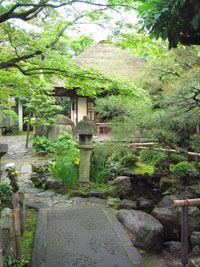BASHO'S FINAL HAIKU - Part I
 After our visit to Ishiyamadera we went looking for Basho's grave, which I'd been surprised to learn was in Otsu (where Basho spent lot of time) and had since wanted to visit. In our fully intact expedition naivete we didn't need a map, of course; who would need a map to find the small-town grave of Japan's most famous poet and the whole world's haiku master?
After our visit to Ishiyamadera we went looking for Basho's grave, which I'd been surprised to learn was in Otsu (where Basho spent lot of time) and had since wanted to visit. In our fully intact expedition naivete we didn't need a map, of course; who would need a map to find the small-town grave of Japan's most famous poet and the whole world's haiku master?We simply got off the train at Ishiyama Station and headed in the general direction down one of the narrow streets that follow the slope toward the Lake, looking for all the signs and other myriad indications that would no doubt surround the famous final precincts of such an illustrious artist - pointing fingersigns, flags, fireworks, billboards, neon signs flashing "This way to Basho's grave," hot dog stands, loudspeakers, haiku recitations, haiku CD hawkers, fleets of tour buses and what not: these would lead us to the location of one of Japan's must-be-most-famous tombs...
There were a lot of interesting shops to see as we walked and walked around and around: a bakery, a mahjong tile shop, a bicycle shop, a great looking sake bar, but just typical old-Japan neighborhood shops, no sign whatsoever that the supreme being of haiku was anywhere within a hundred kilometers of where we journeyed along the narrow road to the deep nowhere. Not even a Basho t-shirt store; I would've bought one. We checked the local area maps that are posted here and there at key intersections to aid seekers of known addresses (buildings in Japan are addressed in the order of their construction, so a known address is about as useful as "go south"), but the maps had never heard of Basho, or his reputed grave.
So we asked a young woman who lived around there, she didn't know. We asked in various shops; an elderly man (the elderly remember the ancient things) said "it's down there somewhere, ask down there." We went down there and asked, they said "ask over there, they might know." Over there they said "it's down that narrow alley over there, you see that alley? Go down there."
We went down the narrow alley, still no signs of any kind bespeaking local pride in the fact that Japan's most famous poet, the guy who wrote the world-renowned frog haiku, was resting just a gravestone's throw away. We came out of the alley and there, from over the non-descript wall of an unassuming precinct along a side street peeked a couple of basho (banana tree) leaves, especially green in the rain. That must be the place. What a haiku, bright basho leaves telling us where Basho was. Bet that was his idea.
Nobody else in the neighborhood seemed to notice. We were the only ones there, for our entire visit. It appears that Basho, who never liked fame and preferred seclusion, had chosen his gravesite well, in a humble place amid local folks who honored his wishes. And there in that small, quiet temple in the rain I encountered another of the many mysteries about Basho...
(To be continued...)


















No comments:
Post a Comment